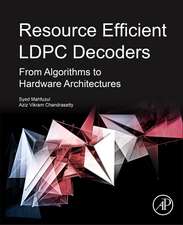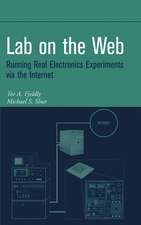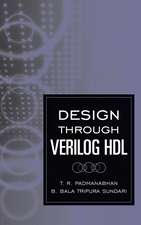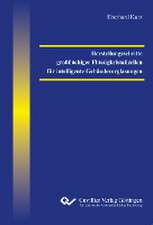Oxy-Fuel Combustion for Power Generation and Carbon Dioxide (CO2) Capture: Woodhead Publishing Series in Energy
Editat de L Zhengen Limba Engleză Paperback – 18 aug 2016
Oxy-fuel combustion for power generation and carbon dioxide (CO2) capture comprehensively reviews the fundamental principles and development of oxy-fuel combustion in fossil-fuel fired utility boilers. Following a foreword by Professor János M. Beér, the book opens with an overview of oxy-fuel combustion technology and its role in a carbon-constrained environment. Part one introduces oxy-fuel combustion further, with a chapter comparing the economics of oxy-fuel vs. post-/pre-combustion CO2 capture, followed by chapters on plant operation, industrial scale demonstrations, and circulating fluidized bed combustion. Part two critically reviews oxy-fuel combustion fundamentals, such as ignition and flame stability, burner design, emissions and heat transfer characteristics, concluding with chapters on O2 production and CO2 compression and purification technologies. Finally, part three explores advanced concepts and developments, such as near-zero flue gas recycle and high-pressure systems, as well as chemical looping combustion and utilisation of gaseous fuel.
With its distinguished editor and internationally renowned contributors, Oxy-fuel combustion for power generation and carbon dioxide (CO2) capture provides a rich resource for power plant designers, operators, and engineers, as well as academics and researchers in the field.
- Comprehensively reviews the fundamental principles and development of oxy-fuel combustion in fossil-fuel fired utility boilers
- Provides an overview of oxy-fuel combustion technology and its role in a carbon-constrained environment
- Introduces oxy-fuel combustion comparing the economics of oxy-fuel vs. post-/pre-combustion CO2 capture
Din seria Woodhead Publishing Series in Energy
-
 Preț: 853.22 lei
Preț: 853.22 lei - 24%
 Preț: 1209.19 lei
Preț: 1209.19 lei - 24%
 Preț: 1307.96 lei
Preț: 1307.96 lei - 24%
 Preț: 1386.95 lei
Preț: 1386.95 lei - 9%
 Preț: 1067.83 lei
Preț: 1067.83 lei - 29%
 Preț: 1071.46 lei
Preț: 1071.46 lei - 9%
 Preț: 950.40 lei
Preț: 950.40 lei - 9%
 Preț: 1011.50 lei
Preț: 1011.50 lei - 29%
 Preț: 1071.13 lei
Preț: 1071.13 lei - 9%
 Preț: 1309.35 lei
Preț: 1309.35 lei - 39%
 Preț: 1047.65 lei
Preț: 1047.65 lei - 9%
 Preț: 949.23 lei
Preț: 949.23 lei - 24%
 Preț: 1688.64 lei
Preț: 1688.64 lei - 9%
 Preț: 1344.70 lei
Preț: 1344.70 lei - 9%
 Preț: 1049.56 lei
Preț: 1049.56 lei - 27%
 Preț: 1937.44 lei
Preț: 1937.44 lei - 23%
 Preț: 1519.01 lei
Preț: 1519.01 lei - 23%
 Preț: 1074.68 lei
Preț: 1074.68 lei - 29%
 Preț: 981.24 lei
Preț: 981.24 lei - 9%
 Preț: 1397.24 lei
Preț: 1397.24 lei - 39%
 Preț: 1397.48 lei
Preț: 1397.48 lei - 9%
 Preț: 945.89 lei
Preț: 945.89 lei - 9%
 Preț: 1073.87 lei
Preț: 1073.87 lei - 9%
 Preț: 1514.09 lei
Preț: 1514.09 lei - 9%
 Preț: 1020.23 lei
Preț: 1020.23 lei - 39%
 Preț: 880.81 lei
Preț: 880.81 lei - 9%
 Preț: 950.94 lei
Preț: 950.94 lei - 39%
 Preț: 1225.96 lei
Preț: 1225.96 lei - 9%
 Preț: 1214.08 lei
Preț: 1214.08 lei - 39%
 Preț: 1085.98 lei
Preț: 1085.98 lei - 9%
 Preț: 868.43 lei
Preț: 868.43 lei - 24%
 Preț: 1615.93 lei
Preț: 1615.93 lei - 31%
 Preț: 927.68 lei
Preț: 927.68 lei - 24%
 Preț: 1077.86 lei
Preț: 1077.86 lei - 9%
 Preț: 946.04 lei
Preț: 946.04 lei - 9%
 Preț: 952.05 lei
Preț: 952.05 lei - 9%
 Preț: 1165.33 lei
Preț: 1165.33 lei - 24%
 Preț: 1307.96 lei
Preț: 1307.96 lei - 29%
 Preț: 1213.47 lei
Preț: 1213.47 lei - 24%
 Preț: 1075.25 lei
Preț: 1075.25 lei - 24%
 Preț: 1048.44 lei
Preț: 1048.44 lei - 29%
 Preț: 1454.22 lei
Preț: 1454.22 lei - 39%
 Preț: 1285.27 lei
Preț: 1285.27 lei - 9%
 Preț: 952.68 lei
Preț: 952.68 lei - 23%
 Preț: 878.04 lei
Preț: 878.04 lei - 9%
 Preț: 951.98 lei
Preț: 951.98 lei - 9%
 Preț: 1209.42 lei
Preț: 1209.42 lei - 9%
 Preț: 1233.82 lei
Preț: 1233.82 lei
Preț: 900.25 lei
Preț vechi: 989.29 lei
-9% Nou
Puncte Express: 1350
Preț estimativ în valută:
172.26€ • 180.34$ • 142.54£
172.26€ • 180.34$ • 142.54£
Carte tipărită la comandă
Livrare economică 29 martie-12 aprilie
Preluare comenzi: 021 569.72.76
Specificații
ISBN-13: 9780081017197
ISBN-10: 0081017197
Pagini: 400
Dimensiuni: 156 x 234 x 21 mm
Greutate: 0.55 kg
Editura: ELSEVIER SCIENCE
Seria Woodhead Publishing Series in Energy
ISBN-10: 0081017197
Pagini: 400
Dimensiuni: 156 x 234 x 21 mm
Greutate: 0.55 kg
Editura: ELSEVIER SCIENCE
Seria Woodhead Publishing Series in Energy
Cuprins
Contributor contact details
Woodhead Publishing Series in Energy
Foreword
Natural Resources Canada: Ressources naturelles Canada
Chapter 1: Overview of oxy-fuel combustion technology for carbon dioxide (CO2) capture
Abstract:
1.1 Introduction
1.2 Oxy-fuel combustion: concepts and components
1.3 Oxy-fuel combustion: background and motivation
1.4 Existing challenges for oxy-fuel combustion technology
1.5 Development of oxy-fuel combustion technology
1.6 About this book
1.7 Acknowledgements
Part I: Introduction to oxy-fuel combustion
Chapter 2: Economic comparison of oxy-coal carbon dioxide (CO2) capture and storage (CCS) with pre- and post-combustion CCS
Abstract:
2.1 Introduction
2.2 Oxy-coal power plant systems scope
2.3 Oxy-coal carbon dioxide (CO2) capture and storage (CCS) cost estimates and comparisons with post- and pre-combustion CO2 capture
2.4 Conclusions
Chapter 3: Oxy-fuel power plant operation
Abstract:
3.1 Introduction
3.2 Flue gas recycle system
3.3 Oxygen (O2) handling
3.4 Leakages
3.5 Slagging and ash formation
3.6 Flue gas cleaning equipment
3.7 Maintenance of oxy-fuel power plants
3.8 Plant control systems
3.9 Conclusion
Chapter 4: Industrial scale oxy-fuel technology demonstration
Abstract:
4.1 Introduction
4.2 Oxy-fuel demonstrations and large pilot plants
4.3 Demonstrations and progress towards commercial deployment
4.4 Conclusions
4.5 Update
4.6 Acknowledgements
Chapter 5: Oxy-fuel combustion on circulating fluidized bed (CFB)
Abstract:
5.1 Introduction
5.2 Early work
5.3 Other test facilities
5.4 CanmetENERGY tests
5.5 Longer duration sulphation tests
5.6 Large pilot-scale and demonstration projects
Part II: Oxy-fuel combustion fundamentals
Chapter 6: Ignition, flame stability, and char combustion in oxy-fuel combustion
Abstract:
6.1 Introduction
6.2 Coal ignition
6.3 Flame stability
6.4 Char combustion
6.5 Carbon burnout
6.6 Conclusions and future trends
Chapter 7: Oxy-coal burner design for utility boilers
Abstract:
7.1 Introduction
7.2 Overview of air-fired burner design methodology
7.3 Changes to burner design criteria and constraints
7.4 Oxy-coal burner principles
7.5 Commercial oxy-coal burners
7.6 Conclusions
Chapter 8: Pollutant formation and emissions from oxy-coal power plants
Abstract:
8.1 Introduction
8.2 Nitrogen oxide (NOx) emissions
8.3 Sulphur oxide (SOx) emissions
8.4 Mercury and trace elements
8.5 Ash formation
8.6 Integrated emissions control
8.7 Vent stream from flue gas compression train
8.8 Conclusion
Chapter 9: Oxy-fuel heat transfer characteristics and impacts on boiler design
Abstract:
9.1 Introduction
9.2 Heat transfer criteria for oxy-fuel combustion
9.3 Theoretical heat transfer analysis
9.4 Computational fluid dynamics (CFD) radiation heat transfer models
9.5 Conclusions
9.6 Acknowledgements
Chapter 10: Current and future oxygen (O2) supply technologies for oxy-fuel combustion
Abstract:
10.1 Introduction
10.2 Oxygen supply needs for oxy-coal power plants
10.3 Vacuum pressure swing adsorption technology
10.4 Cryogenic air separation technology
10.5 Oxygen transport membrane (OTM) technology
10.6 Future trends
10.7 Acknowledgements
Chapter 11: Carbon dioxide (CO2) compression and purification technology for oxy-fuel combustion
Abstract:
11.1 Introduction
11.2 Industrial carbon dioxide (CO2) production process
11.3 Oxy-fuel flue gas CO2 purification process
11.4 Recent advances in the oxy-fuel flue gas CO2 purification technology
11.5 Environmental performance of oxy-fuel power plant
11.6 Future trends
11.7 Conclusions
11.8 Acknowledgements
Part III: Advanced oxy-fuel combustion concepts and developments
Chapter 12: Direct oxy-coal combustion with minimum or no flue gas recycle
Abstract:
12.1 Introduction
12.2 Prior work on near zero flue gas recycle oxy-fuel fired boilers
12.3 Design considerations for near zero flue gas recycle
12.4 Separate fired chambers for different steam circuits
12.5 Furnace with controlled radiant heating of superheaters and reheaters
12.6 Furnace with distributed firing
12.7 Furnace with multiple partition walls
12.8 Conclusion
Chapter 13: High pressure oxy-fuel (HiPrOx) combustion systems
Abstract:
13.1 Introduction
13.2 Rankine cycle power systems
13.3 Uses of pressure in power systems
13.4 Equipment and operational considerations
13.5 Other high pressure power generation systems
13.6 The industrial sector
13.7 Future trends
13.8 Acknowledgements
Chapter 14: Chemical-looping combustion for power generation and carbon dioxide (CO2) capture
Abstract:
14.1 Introduction
14.2 Principle of systems integration for chemical-looping combustion
14.3 Solid looping materials
14.4 Design of chemical-looping combustion systems
14.5 Chemical-looping combustion systems with different fuels
14.6 Future trends
14.7 Conclusions
Chapter 15: Oxy-fuel combustion of gaseous fuel
Abstract:
15.1 Introduction
15.2 Thermodynamic cycles using conventional air separation technology
15.3 Thermodynamic cycles using advanced air separation technologies
15.4 Use of solid fuel with gasification technology
15.5 Future trends
Index
Woodhead Publishing Series in Energy
Foreword
Natural Resources Canada: Ressources naturelles Canada
Chapter 1: Overview of oxy-fuel combustion technology for carbon dioxide (CO2) capture
Abstract:
1.1 Introduction
1.2 Oxy-fuel combustion: concepts and components
1.3 Oxy-fuel combustion: background and motivation
1.4 Existing challenges for oxy-fuel combustion technology
1.5 Development of oxy-fuel combustion technology
1.6 About this book
1.7 Acknowledgements
Part I: Introduction to oxy-fuel combustion
Chapter 2: Economic comparison of oxy-coal carbon dioxide (CO2) capture and storage (CCS) with pre- and post-combustion CCS
Abstract:
2.1 Introduction
2.2 Oxy-coal power plant systems scope
2.3 Oxy-coal carbon dioxide (CO2) capture and storage (CCS) cost estimates and comparisons with post- and pre-combustion CO2 capture
2.4 Conclusions
Chapter 3: Oxy-fuel power plant operation
Abstract:
3.1 Introduction
3.2 Flue gas recycle system
3.3 Oxygen (O2) handling
3.4 Leakages
3.5 Slagging and ash formation
3.6 Flue gas cleaning equipment
3.7 Maintenance of oxy-fuel power plants
3.8 Plant control systems
3.9 Conclusion
Chapter 4: Industrial scale oxy-fuel technology demonstration
Abstract:
4.1 Introduction
4.2 Oxy-fuel demonstrations and large pilot plants
4.3 Demonstrations and progress towards commercial deployment
4.4 Conclusions
4.5 Update
4.6 Acknowledgements
Chapter 5: Oxy-fuel combustion on circulating fluidized bed (CFB)
Abstract:
5.1 Introduction
5.2 Early work
5.3 Other test facilities
5.4 CanmetENERGY tests
5.5 Longer duration sulphation tests
5.6 Large pilot-scale and demonstration projects
Part II: Oxy-fuel combustion fundamentals
Chapter 6: Ignition, flame stability, and char combustion in oxy-fuel combustion
Abstract:
6.1 Introduction
6.2 Coal ignition
6.3 Flame stability
6.4 Char combustion
6.5 Carbon burnout
6.6 Conclusions and future trends
Chapter 7: Oxy-coal burner design for utility boilers
Abstract:
7.1 Introduction
7.2 Overview of air-fired burner design methodology
7.3 Changes to burner design criteria and constraints
7.4 Oxy-coal burner principles
7.5 Commercial oxy-coal burners
7.6 Conclusions
Chapter 8: Pollutant formation and emissions from oxy-coal power plants
Abstract:
8.1 Introduction
8.2 Nitrogen oxide (NOx) emissions
8.3 Sulphur oxide (SOx) emissions
8.4 Mercury and trace elements
8.5 Ash formation
8.6 Integrated emissions control
8.7 Vent stream from flue gas compression train
8.8 Conclusion
Chapter 9: Oxy-fuel heat transfer characteristics and impacts on boiler design
Abstract:
9.1 Introduction
9.2 Heat transfer criteria for oxy-fuel combustion
9.3 Theoretical heat transfer analysis
9.4 Computational fluid dynamics (CFD) radiation heat transfer models
9.5 Conclusions
9.6 Acknowledgements
Chapter 10: Current and future oxygen (O2) supply technologies for oxy-fuel combustion
Abstract:
10.1 Introduction
10.2 Oxygen supply needs for oxy-coal power plants
10.3 Vacuum pressure swing adsorption technology
10.4 Cryogenic air separation technology
10.5 Oxygen transport membrane (OTM) technology
10.6 Future trends
10.7 Acknowledgements
Chapter 11: Carbon dioxide (CO2) compression and purification technology for oxy-fuel combustion
Abstract:
11.1 Introduction
11.2 Industrial carbon dioxide (CO2) production process
11.3 Oxy-fuel flue gas CO2 purification process
11.4 Recent advances in the oxy-fuel flue gas CO2 purification technology
11.5 Environmental performance of oxy-fuel power plant
11.6 Future trends
11.7 Conclusions
11.8 Acknowledgements
Part III: Advanced oxy-fuel combustion concepts and developments
Chapter 12: Direct oxy-coal combustion with minimum or no flue gas recycle
Abstract:
12.1 Introduction
12.2 Prior work on near zero flue gas recycle oxy-fuel fired boilers
12.3 Design considerations for near zero flue gas recycle
12.4 Separate fired chambers for different steam circuits
12.5 Furnace with controlled radiant heating of superheaters and reheaters
12.6 Furnace with distributed firing
12.7 Furnace with multiple partition walls
12.8 Conclusion
Chapter 13: High pressure oxy-fuel (HiPrOx) combustion systems
Abstract:
13.1 Introduction
13.2 Rankine cycle power systems
13.3 Uses of pressure in power systems
13.4 Equipment and operational considerations
13.5 Other high pressure power generation systems
13.6 The industrial sector
13.7 Future trends
13.8 Acknowledgements
Chapter 14: Chemical-looping combustion for power generation and carbon dioxide (CO2) capture
Abstract:
14.1 Introduction
14.2 Principle of systems integration for chemical-looping combustion
14.3 Solid looping materials
14.4 Design of chemical-looping combustion systems
14.5 Chemical-looping combustion systems with different fuels
14.6 Future trends
14.7 Conclusions
Chapter 15: Oxy-fuel combustion of gaseous fuel
Abstract:
15.1 Introduction
15.2 Thermodynamic cycles using conventional air separation technology
15.3 Thermodynamic cycles using advanced air separation technologies
15.4 Use of solid fuel with gasification technology
15.5 Future trends
Index
















